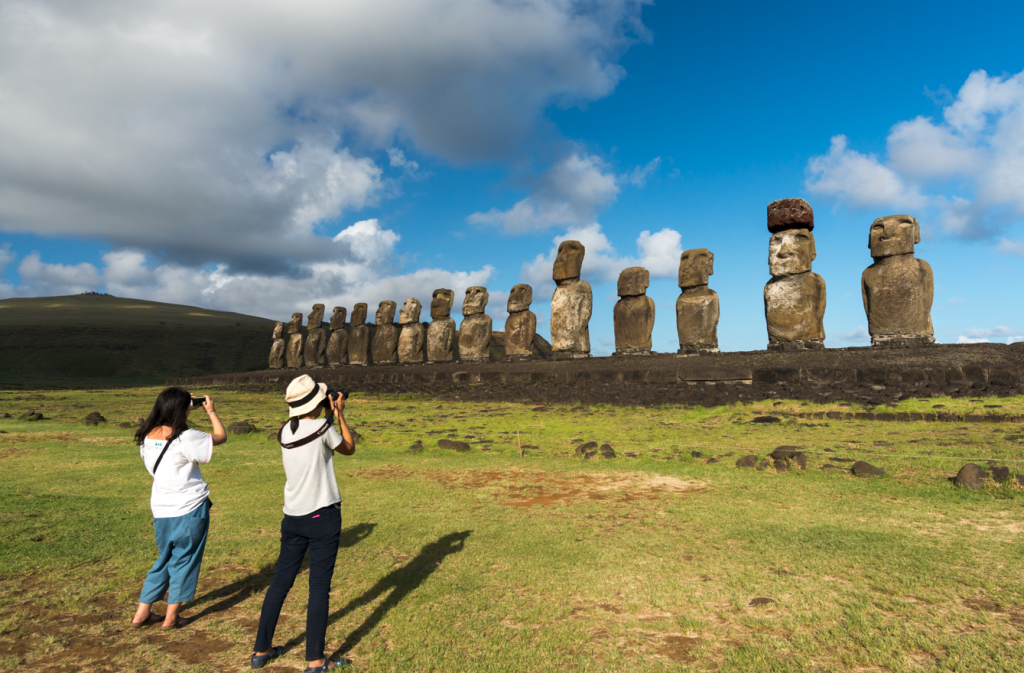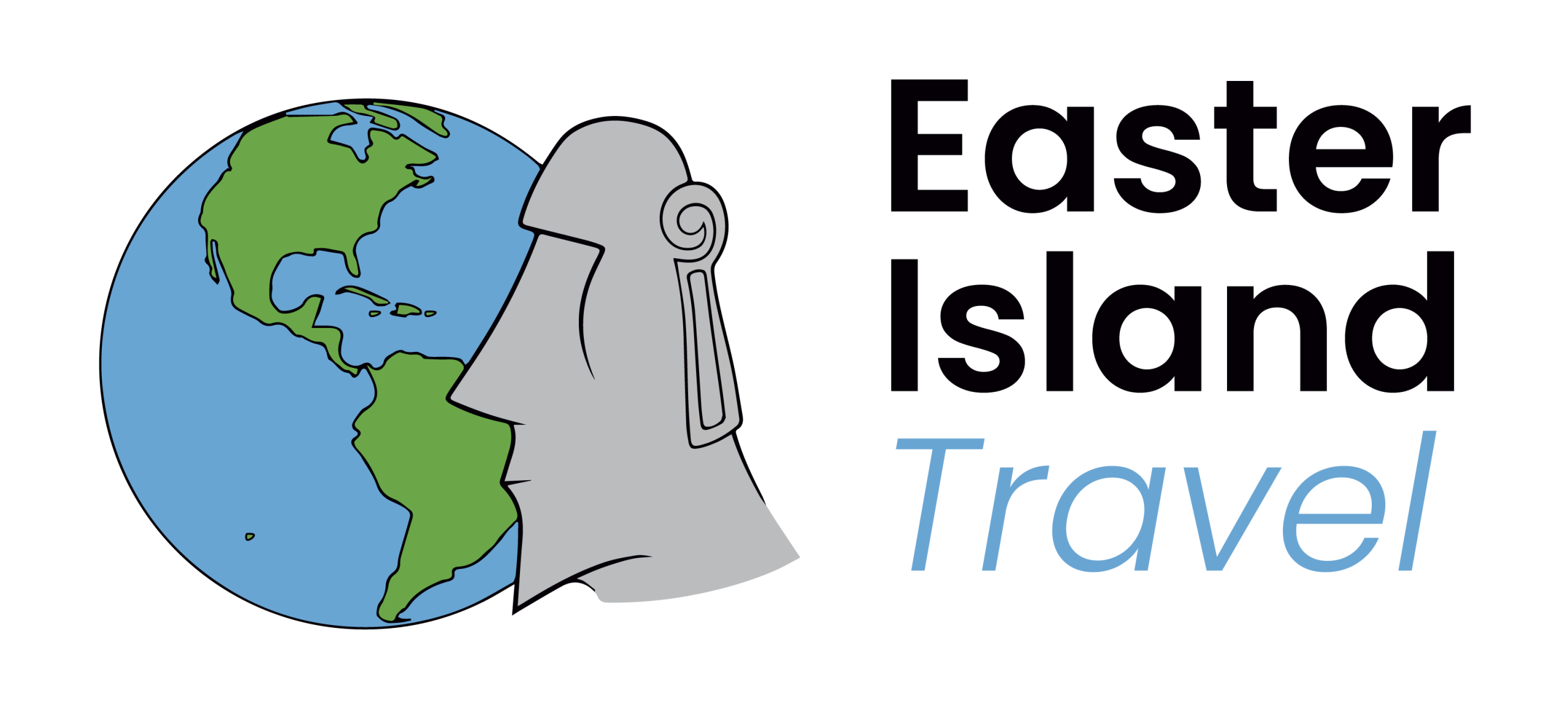If you ever walk into a house, museum or workshop on Rapa Nui, you might come across a thin wooden figure, with clearly marked ribs and a deep stare. It’s the Moai Kava Kava, one of the most iconic and mysterious carved figures of Rapanui art.
Unlike the large stone moai that face the sea, this one is smaller, more intimate, but just as powerful.

What does “Kava Kava” mean?
In the Rapanui language, “kava kava” means ribs. And just looking at one you’ll know why. These figures represent a skeletal man, with a sunken belly, long torso, short limbs and small feet. His face is sharp, with a hooked or prominent-bridged nose, marked cheekbones and often a small beard.
He has long, pointed ears, and very open eyes made of bone and obsidian that give him an expression between astonishment and watchfulness. Some figures have reliefs on the skull, others wear a kind of helmet, and some have been found adorned with human hair.
While most Moai Kava Kava are male, there are also female versions called Moai Papa’a. These are rarer and recognised by their flat shapes, hanging breasts and harsher features almost masculine.

The origin: a legend still told
The story of the Moai Kava Kava begins with Tu’u Koihu. One night, while walking through the area of Puna Pau, Tu’u Koihu came across two aku aku (spirits from the other world) sleeping in the middle of the path. They were so thin their bones showed.
When he tried to leave quietly the spirits awoke and followed him, afraid he would tell what he had seen. Tu’u Koihu pledged to keep silent. After two days and two nights of their watch, the spirits finally left. Then the ariki (chief) took a piece of toromiro wood and carved the image of those famished beings he could not forget.
Thus was born the first Moai Kava Kava “the image with ribs”. From that time, islanders began carving them and hanging them inside their homes as protection, to frighten off evil spirits.

More than art: a connection to the spiritual world
It is said that when someone broke a tapu (a sacred rule), after dying their spirit would transform into an aku aku: a being that wanders between the physical and spiritual world.
The Moai Kava Kava, then, would be representations of these spirits. That’s why, beyond being artistic pieces, they carry deep symbolic weight: they remind us of respect for sacred rules and the ties between the living and the dead.

Wood and legacy
Originally carved in toromiro a native tree now nearly extinct though being re-introduced on the island today other types of wood are used, but the essence remains the same: each figure is unique, hand carved, without moulds, and carries knowledge passed down generations.
Today, original Moai Kava Kava figures can be found in major museums of the world (the British Museum, the Met, the LACMA, Te Papa, among others). However, in Rapa Nui you can still see them in the Museo Antropológico Sebastián Englert and in the local artisan workshops that keep the ancestral tradition alive.

More than a souvenir
The Moai Kava Kava is not just a souvenir. It’s a voice from the past that evokes the spiritual strength of the Rapanui people and their way of representing life, death and memory. Its appearance may seem unsettling but it also holds something very human: vulnerability, wisdom, the balance between body and spirit.
At Easter Island Travel we include this story in our tours, visiting workshops and cultural spaces where you can see how these figures are carved, understand their symbolism and hear directly from Rapanui people about their meaning.

How to experience this with respect?
- Inform yourself before you travel. Knowing the story makes your visit more meaningful.
- Support the local artisans. Buy directly from those who carve with respect and transmit tradition.
- Care for sacred spaces and museums. Not everything can be touched or photographed.
- Listen. Oral stories are the soul of Rapanui culture.
We promote responsible tourism, in small groups and with local guides who help you look beyond the surface.

A figure that returns your gaze
The Moai Kava Kava doesn’t impress by size but by presence. When you look at it, you won’t just see a carving: you’ll see a story of encounters, fears, respect and survival.
And if you decide to meet it here, on its land, we promise that its wise and hollow stare will not leave you.

At Easter Island Travel, we’re that agency with local expertise, certified guides, and recognition as TripAdvisor’s #1 Tour Operator, we’ll make sure you don’t just visit Easter Island…
You’ll feel it, live it, and remember it forever.
Contact us today to design your ideal itinerary and let us show you Rapa Nui as only those who truly live the island can.
#TapatiRapaNui #EasterIsland #RapaNuiCulture #CulturalFestival #PolynesianHeritage #TravelToEasterIsland #UniqueExperiences #BucketListTravel #IslandLife #FestivalVibes #Orongo #RanoKau #VolcanoViews #AncientVillage #CliffViewsRapaNui #AhuTongariki #15Moai #SunriseRapaNui #MoaiMonuments #IconicRapaNui #RanoRaraku #AnakenaBeach #TropicalParadise #AhuAkivi #Terevaka #moaikavakava #kavakava #TourOperator
Fuentes / referencias en español
- “Moái Kava-Kava” (Wikipedia en español): https://es.wikipedia.org/wiki/Mo%C3%A1i_Kava-Kava Wikipedia
- “MOAI KAVA KAVA | El espíritu con costillas de Isla de Pascua” (Imaginarapanui): https://imaginarapanui.com/moai-kava-kava/ Imaginarapanui
- “Espíritus tutelares Rapa Nui” (Museo Chileno de Arte Precolombino): https://museo.precolombino.cl/espiritus-tutelares-rapa-nui/ museo.precolombino.cl
- “Mitos y leyendas de Rapa Nui – Moai Kava-Kava” (Rapa Nui Travel Guide): https://rapanuitravelguide.com/es/rapa-nui/rapa-nui-culture/myths-and-legends/ rapanuitravelguide.com

